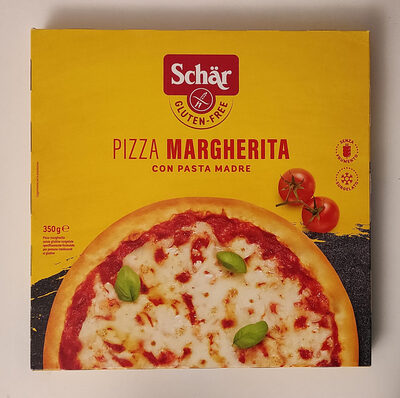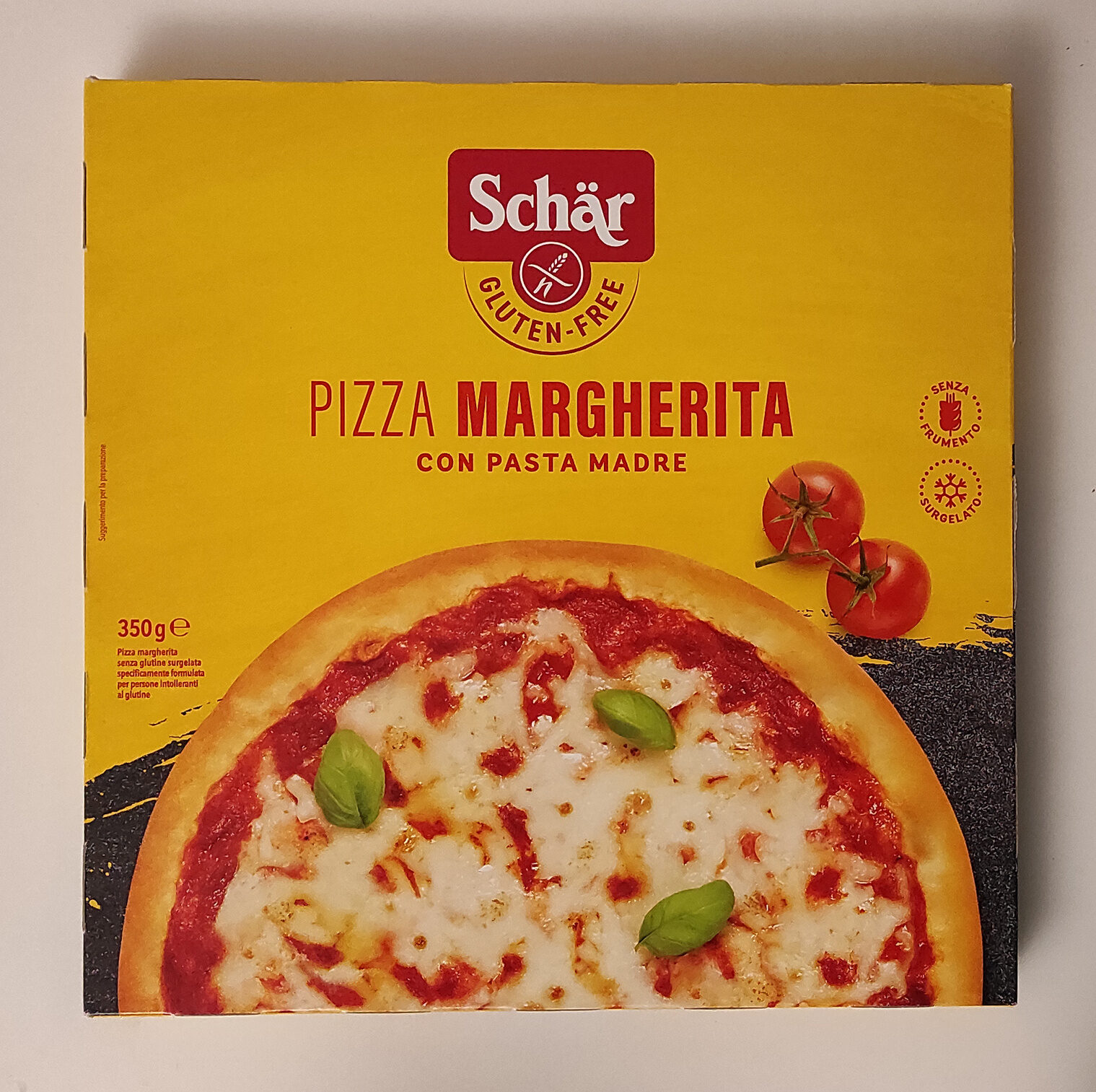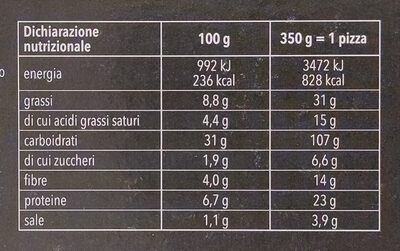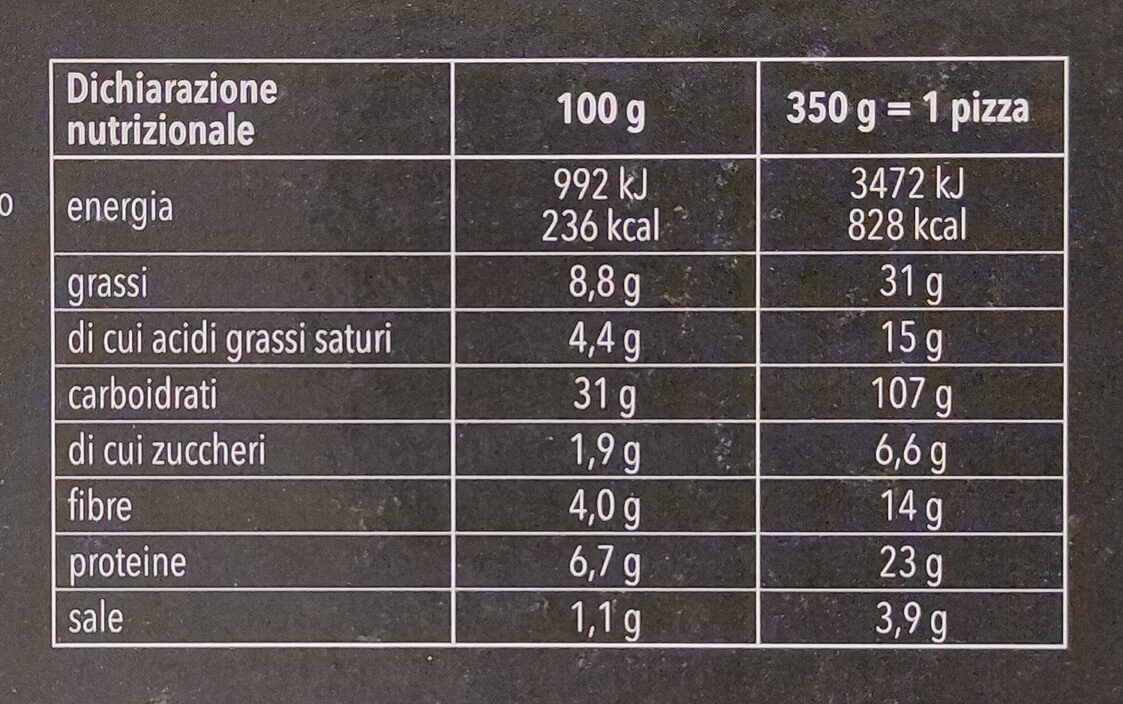Help us make food transparency the norm!
As a non-profit organization, we depend on your donations to continue informing consumers around the world about what they eat.
The food revolution starts with you!
Pizza Margherita - Schär - 350 g
Pizza Margherita - Schär - 350 g
This product page is not complete. You can help to complete it by editing it and adding more data from the photos we have, or by taking more photos using the app for Android or iPhone/iPad. Thank you!
×
Barcode: 8008698024379 (EAN / EAN-13)
Quantity: 350 g
Packaging:
Box, Cardboard, Non-corrugated cardboard, LDPE 4 - Low-density polyethylene, Green Dot
Brands: Schär
Categories: Frozen foods, Meals, Pizzas pies and quiches, Pizzas, Vegetarian pizzas, Frozen pizzas and pies, Frozen pizzas, Margherita Pizza
Labels, certifications, awards:
No gluten, Vegetarian, Crossed Grain Trademark, FSC, FSC Mix, No eggs, No wheat
Origin of the product and/or its ingredients: Italy
Origin of ingredients: Italy
Traceability code: IT 995 L/P CE
Link to the product page on the official site of the producer: https://www.schaer.com/it-it/p/pizza-mar...
Stores: Iper
Matching with your preferences
Health
Ingredients
-
46 ingredients
Base 57%: maize starch, water, rice flour, sour dough 11% (rice flour, water), thickeners: cellulose, hydroxypropyl methyl cellulose; rice starch, extra virgin olive oil 3,9%, yeast, maize flour, sunflower oil, iodised salt (salt, potassium iodide), fruit extracts (carob, apple), sugar, dextrose, raising agents: sodium hydrogen carbonate, glucono-delta-lactone; acids: tartaric acid, citric acid. Topping 43%: mozzarella cheese 56% (pasteurised milk, salt, microbial rennet), tomato puree 43%, iodised salt (salt, potassium iodide), oregano.Allergens: MilkTraces: Soybeans
Food processing
-
Ultra processed foods
Elements that indicate the product is in the 4 - Ultra processed food and drink products group:
- Additive: E460 - Cellulose
- Additive: E464 - Hydroxypropyl methyl cellulose
- Ingredient: Dextrose
- Ingredient: Glucose
- Ingredient: Thickener
Food products are classified into 4 groups according to their degree of processing:
- Unprocessed or minimally processed foods
- Processed culinary ingredients
- Processed foods
- Ultra processed foods
The determination of the group is based on the category of the product and on the ingredients it contains.
Additives
-
E330 - Citric acid
Citric acid is a natural organic acid found in citrus fruits such as lemons, oranges, and limes.
It is widely used in the food industry as a flavor enhancer, acidulant, and preservative due to its tart and refreshing taste.
Citric acid is safe for consumption when used in moderation and is considered a generally recognized as safe (GRAS) food additive by regulatory agencies worldwide.
-
E334 - L(+)-tartaric acid
Tartaric acid: Tartaric acid is a white, crystalline organic acid that occurs naturally in many fruits, most notably in grapes, but also in bananas, tamarinds, and citrus. Its salt, potassium bitartrate, commonly known as cream of tartar, develops naturally in the process of winemaking. It is commonly mixed with sodium bicarbonate and is sold as baking powder used as a leavening agent in food preparation. The acid itself is added to foods as an antioxidant and to impart its distinctive sour taste. Tartaric is an alpha-hydroxy-carboxylic acid, is diprotic and aldaric in acid characteristics, and is a dihydroxyl derivative of succinic acid.Source: Wikipedia
-
E460 - Cellulose
Cellulose: Cellulose is an organic compound with the formula -C6H10O5-n, a polysaccharide consisting of a linear chain of several hundred to many thousands of β-1→4- linked D-glucose units. Cellulose is an important structural component of the primary cell wall of green plants, many forms of algae and the oomycetes. Some species of bacteria secrete it to form biofilms. Cellulose is the most abundant organic polymer on Earth. The cellulose content of cotton fiber is 90%, that of wood is 40–50%, and that of dried hemp is approximately 57%.Cellulose is mainly used to produce paperboard and paper. Smaller quantities are converted into a wide variety of derivative products such as cellophane and rayon. Conversion of cellulose from energy crops into biofuels such as cellulosic ethanol is under development as a renewable fuel source. Cellulose for industrial use is mainly obtained from wood pulp and cotton.Some animals, particularly ruminants and termites, can digest cellulose with the help of symbiotic micro-organisms that live in their guts, such as Trichonympha. In human nutrition, cellulose is a non-digestible constituent of insoluble dietary fiber, acting as a hydrophilic bulking agent for feces and potentially aiding in defecation.Source: Wikipedia
-
E464 - Hydroxypropyl methyl cellulose
Hypromellose: Hypromellose -INN-, short for hydroxypropyl methylcellulose -HPMC-, is a semisynthetic, inert, viscoelastic polymer used as eye drops, as well as an excipient and controlled-delivery component in oral medicaments, found in a variety of commercial products.As a food additive, hypromellose is an emulsifier, thickening and suspending agent, and an alternative to animal gelatin. Its Codex Alimentarius code -E number- is E464.Source: Wikipedia
-
E500 - Sodium carbonates
Sodium carbonates (E500) are compounds commonly used in food preparation as leavening agents, helping baked goods rise by releasing carbon dioxide when they interact with acids.
Often found in baking soda, they regulate the pH of food, preventing it from becoming too acidic or too alkaline. In the culinary world, sodium carbonates can also enhance the texture and structure of foods, such as noodles, by modifying the gluten network.
Generally recognized as safe, sodium carbonates are non-toxic when consumed in typical amounts found in food.
-
E500i - Sodium carbonate
Sodium carbonate: Sodium carbonate, Na2CO3, -also known as washing soda, soda ash and soda crystals, and in the monohydrate form as crystal carbonate- is the water-soluble sodium salt of carbonic acid. It most commonly occurs as a crystalline decahydrate, which readily effloresces to form a white powder, the monohydrate. Pure sodium carbonate is a white, odorless powder that is hygroscopic -absorbs moisture from the air-. It has a strongly alkaline taste, and forms a moderately basic solution in water. Sodium carbonate is well known domestically for its everyday use as a water softener. Historically it was extracted from the ashes of plants growing in sodium-rich soils, such as vegetation from the Middle East, kelp from Scotland and seaweed from Spain. Because the ashes of these sodium-rich plants were noticeably different from ashes of timber -used to create potash-, they became known as "soda ash". It is synthetically produced in large quantities from salt -sodium chloride- and limestone by a method known as the Solvay process. The manufacture of glass is one of the most important uses of sodium carbonate. Sodium carbonate acts as a flux for silica, lowering the melting point of the mixture to something achievable without special materials. This "soda glass" is mildly water-soluble, so some calcium carbonate is added to the melt mixture to make the glass produced insoluble. This type of glass is known as soda lime glass: "soda" for the sodium carbonate and "lime" for the calcium carbonate. Soda lime glass has been the most common form of glass for centuries. Sodium carbonate is also used as a relatively strong base in various settings. For example, it is used as a pH regulator to maintain stable alkaline conditions necessary for the action of the majority of photographic film developing agents. It acts as an alkali because when dissolved in water, it dissociates into the weak acid: carbonic acid and the strong alkali: sodium hydroxide. This gives sodium carbonate in solution the ability to attack metals such as aluminium with the release of hydrogen gas.It is a common additive in swimming pools used to raise the pH which can be lowered by chlorine tablets and other additives which contain acids. In cooking, it is sometimes used in place of sodium hydroxide for lyeing, especially with German pretzels and lye rolls. These dishes are treated with a solution of an alkaline substance to change the pH of the surface of the food and improve browning. In taxidermy, sodium carbonate added to boiling water will remove flesh from the bones of animal carcasses for trophy mounting or educational display. In chemistry, it is often used as an electrolyte. Electrolytes are usually salt-based, and sodium carbonate acts as a very good conductor in the process of electrolysis. In addition, unlike chloride ions, which form chlorine gas, carbonate ions are not corrosive to the anodes. It is also used as a primary standard for acid-base titrations because it is solid and air-stable, making it easy to weigh accurately.Source: Wikipedia
-
E500ii - Sodium hydrogen carbonate
Sodium hydrogen carbonate, also known as E500ii, is a food additive commonly used as a leavening agent.
When added to recipes, it releases carbon dioxide gas upon exposure to heat or acids, causing dough to rise and resulting in a light, fluffy texture in baked goods.
It is generally recognized as safe (GRAS) by regulatory authorities when used in appropriate quantities and poses no significant health risks when consumed in typical food applications.
-
E575 - Glucono-delta-lactone
Glucono delta-lactone: Glucono delta-lactone -GDL-, also known as gluconolactone, is a food additive with the E number E575 used as a sequestrant, an acidifier, or a curing, pickling, or leavening agent. It is a lactone of D-gluconic acid. Pure GDL is a white odorless crystalline powder. GDL has been marketed for use in feta cheese. GDL is neutral, but hydrolyses in water to gluconic acid which is acidic, adding a tangy taste to foods, though it has roughly a third of the sourness of citric acid. It is metabolized to 6-phospho-D-gluconate; one gram of GDL yields roughly the same amount of metabolic energy as one gram of sugar. Upon addition to water, GDL is partially hydrolysed to gluconic acid, with the balance between the lactone form and the acid form established as a chemical equilibrium. The rate of hydrolysis of GDL is increased by heat and high pH.The yeast Saccharomyces bulderi can be used to ferment gluconolactone to ethanol and carbon dioxide. The pH value greatly affects culture growth. Gluconolactone at 1 or 2% in a mineral media solution causes the pH to drop below 3.It is also a complete inhibitor of the enzyme amygdalin beta-glucosidase at concentrations of 1 mM.Source: Wikipedia
Ingredients analysis
-
Palm oil free
No ingredients containing palm oil detected
Unrecognized ingredients: it:base, it:pasta-madre, it:i-e-ii, it:glucono-delta-lattone, it:farcituraSome ingredients could not be recognized.
We need your help!
You can help us recognize more ingredients and better analyze the list of ingredients for this product and others:
- Edit this product page to correct spelling mistakes in the ingredients list, and/or to remove ingredients in other languages and sentences that are not related to the ingredients.
- Add new entries, synonyms or translations to our multilingual lists of ingredients, ingredient processing methods, and labels.
If you would like to help, join the #ingredients channel on our Slack discussion space and/or learn about ingredients analysis on our wiki. Thank you!
-
Non-vegan
Non-vegan ingredients: Mozzarella, Pasteurised milkSome ingredients could not be recognized.
We need your help!
You can help us recognize more ingredients and better analyze the list of ingredients for this product and others:
- Edit this product page to correct spelling mistakes in the ingredients list, and/or to remove ingredients in other languages and sentences that are not related to the ingredients.
- Add new entries, synonyms or translations to our multilingual lists of ingredients, ingredient processing methods, and labels.
If you would like to help, join the #ingredients channel on our Slack discussion space and/or learn about ingredients analysis on our wiki. Thank you!
-
Vegetarian
No non-vegetarian ingredients detected
Unrecognized ingredients: it:base, it:pasta-madre, it:i-e-ii, it:glucono-delta-lattone, it:farcituraSome ingredients could not be recognized.
We need your help!
You can help us recognize more ingredients and better analyze the list of ingredients for this product and others:
- Edit this product page to correct spelling mistakes in the ingredients list, and/or to remove ingredients in other languages and sentences that are not related to the ingredients.
- Add new entries, synonyms or translations to our multilingual lists of ingredients, ingredient processing methods, and labels.
If you would like to help, join the #ingredients channel on our Slack discussion space and/or learn about ingredients analysis on our wiki. Thank you!
-
Details of the analysis of the ingredients
We need your help!
Some ingredients could not be recognized.
We need your help!
You can help us recognize more ingredients and better analyze the list of ingredients for this product and others:
- Edit this product page to correct spelling mistakes in the ingredients list, and/or to remove ingredients in other languages and sentences that are not related to the ingredients.
- Add new entries, synonyms or translations to our multilingual lists of ingredients, ingredient processing methods, and labels.
If you would like to help, join the #ingredients channel on our Slack discussion space and/or learn about ingredients analysis on our wiki. Thank you!
: Base 57% (amido di mais), acqua, farina di riso, pasta madre 11% (farina di riso, acqua), addensanti (cellulosa (e460 (i e ii ???))), idrossipropilmetilcellulosa (e464), amido di riso, olio extra vergine di oliva 3.9%, lievito, farina di mais, olio di semi di girasole, sale iodato (sale, ioduro di potassio), frutta (semi di carrube, mela), zucchero, destrosio, agenti lievitanti (carbonato acido di sodio (e500i)), glucono delta lattone (e575), acidificanti (acido tartarico (e334)), acido citrico (e330), Farcitura 43% (mozzarella 56%, _latte_ pastorizzato), sale, caglio microbico, passata di pomodoro 43%, sale iodato (sale, ioduro di potassio), origano- Base -> it:base - percent: 57
- amido di mais -> en:corn-starch - vegan: yes - vegetarian: yes - ciqual_food_code: 9510
- acqua -> en:water - vegan: yes - vegetarian: yes - ciqual_food_code: 18066
- farina di riso -> en:rice-flour - vegan: yes - vegetarian: yes - ciqual_food_code: 9520
- pasta madre -> it:pasta-madre - percent: 11
- farina di riso -> en:rice-flour - vegan: yes - vegetarian: yes - ciqual_food_code: 9520
- acqua -> en:water - vegan: yes - vegetarian: yes - ciqual_food_code: 18066
- addensanti -> en:thickener
- cellulosa -> en:e460 - vegan: yes - vegetarian: yes
- e460 -> en:e460 - vegan: yes - vegetarian: yes
- i e ii ??? -> it:i-e-ii
- e460 -> en:e460 - vegan: yes - vegetarian: yes
- cellulosa -> en:e460 - vegan: yes - vegetarian: yes
- idrossipropilmetilcellulosa -> en:e464 - vegan: yes - vegetarian: yes
- e464 -> en:e464 - vegan: yes - vegetarian: yes
- amido di riso -> en:rice-starch - vegan: yes - vegetarian: yes - ciqual_proxy_food_code: 9510
- olio extra vergine di oliva -> en:extra-virgin-olive-oil - vegan: yes - vegetarian: yes - from_palm_oil: no - ciqual_food_code: 17270 - percent: 3.9
- lievito -> en:yeast - vegan: yes - vegetarian: yes
- farina di mais -> en:corn-flour - vegan: yes - vegetarian: yes - ciqual_food_code: 9545
- olio di semi di girasole -> en:sunflower-oil - vegan: yes - vegetarian: yes - from_palm_oil: no - ciqual_food_code: 17440
- sale iodato -> en:iodised-salt - vegan: yes - vegetarian: yes - ciqual_food_code: 11058
- sale -> en:salt - vegan: yes - vegetarian: yes - ciqual_food_code: 11058
- ioduro di potassio -> en:potassium-iodide - vegan: yes - vegetarian: yes - ciqual_food_code: 11058
- frutta -> en:fruit - vegan: yes - vegetarian: yes
- semi di carrube -> en:carob-seed-flour - vegan: yes - vegetarian: yes - ciqual_proxy_food_code: 9410
- mela -> en:apple - vegan: yes - vegetarian: yes - ciqual_food_code: 13050
- zucchero -> en:sugar - vegan: yes - vegetarian: yes - ciqual_proxy_food_code: 31016
- destrosio -> en:dextrose - vegan: yes - vegetarian: yes - ciqual_proxy_food_code: 31016
- agenti lievitanti -> en:raising-agent
- carbonato acido di sodio -> en:e500ii - vegan: yes - vegetarian: yes
- e500i -> en:e500i - vegan: yes - vegetarian: yes
- carbonato acido di sodio -> en:e500ii - vegan: yes - vegetarian: yes
- glucono delta lattone -> it:glucono-delta-lattone
- e575 -> en:e575 - vegan: yes - vegetarian: yes
- acidificanti -> en:acid
- acido tartarico -> en:e334 - vegan: yes - vegetarian: yes
- e334 -> en:e334 - vegan: yes - vegetarian: yes
- acido tartarico -> en:e334 - vegan: yes - vegetarian: yes
- acido citrico -> en:e330 - vegan: yes - vegetarian: yes
- e330 -> en:e330 - vegan: yes - vegetarian: yes
- Farcitura -> it:farcitura - percent: 43
- mozzarella -> en:mozzarella - vegan: no - vegetarian: maybe - ciqual_food_code: 19590 - percent: 56
- _latte_ pastorizzato -> en:pasteurised-milk - vegan: no - vegetarian: yes - ciqual_proxy_food_code: 19051
- sale -> en:salt - vegan: yes - vegetarian: yes - ciqual_food_code: 11058
- caglio microbico -> en:microbial-rennet - vegan: yes - vegetarian: yes
- passata di pomodoro -> en:sifted-tomato - vegan: yes - vegetarian: yes - ciqual_food_code: 20047 - percent: 43
- sale iodato -> en:iodised-salt - vegan: yes - vegetarian: yes - ciqual_food_code: 11058
- sale -> en:salt - vegan: yes - vegetarian: yes - ciqual_food_code: 11058
- ioduro di potassio -> en:potassium-iodide - vegan: yes - vegetarian: yes - ciqual_food_code: 11058
- origano -> en:oregano - vegan: yes - vegetarian: yes - ciqual_proxy_food_code: 11035
Nutrition
-
Good nutritional quality
⚠ ️Warning: the amount of fruits, vegetables and nuts is not specified on the label, it was estimated from the list of ingredients: 46This product is not considered a beverage for the calculation of the Nutri-Score.
Positive points: 9
- Proteins: 4 / 5 (value: 6.7, rounded value: 6.7)
- Fiber: 4 / 5 (value: 4, rounded value: 4)
- Fruits, vegetables, nuts, and colza/walnut/olive oils: 1 / 5 (value: 46.9, rounded value: 46.9)
Negative points: 10
- Energy: 2 / 10 (value: 992, rounded value: 992)
- Sugars: 0 / 10 (value: 1.9, rounded value: 1.9)
- Saturated fat: 4 / 10 (value: 4.4, rounded value: 4.4)
- Sodium: 4 / 10 (value: 440, rounded value: 440)
The points for proteins are counted because the negative points are less than 11.
Nutritional score: (10 - 9)
Nutri-Score:
-
Nutrient levels
-
Fat in moderate quantity (8.8%)
What you need to know- A high consumption of fat, especially saturated fats, can raise cholesterol, which increases the risk of heart diseases.
Recommendation: Limit the consumption of fat and saturated fat- Choose products with lower fat and saturated fat content.
-
Saturated fat in moderate quantity (4.4%)
What you need to know- A high consumption of fat, especially saturated fats, can raise cholesterol, which increases the risk of heart diseases.
Recommendation: Limit the consumption of fat and saturated fat- Choose products with lower fat and saturated fat content.
-
Sugars in low quantity (1.9%)
What you need to know- A high consumption of sugar can cause weight gain and tooth decay. It also augments the risk of type 2 diabetes and cardio-vascular diseases.
Recommendation: Limit the consumption of sugar and sugary drinks- Sugary drinks (such as sodas, fruit beverages, and fruit juices and nectars) should be limited as much as possible (no more than 1 glass a day).
- Choose products with lower sugar content and reduce the consumption of products with added sugars.
-
Salt in moderate quantity (1.1%)
What you need to know- A high consumption of salt (or sodium) can cause raised blood pressure, which can increase the risk of heart disease and stroke.
- Many people who have high blood pressure do not know it, as there are often no symptoms.
- Most people consume too much salt (on average 9 to 12 grams per day), around twice the recommended maximum level of intake.
Recommendation: Limit the consumption of salt and salted food- Reduce the quantity of salt used when cooking, and don't salt again at the table.
- Limit the consumption of salty snacks and choose products with lower salt content.
-
-
Nutrition facts
Nutrition facts As sold
for 100 g / 100 mlAs sold
per serving (350 g)Compared to: Margherita Pizza Energy 992 kj
(236 kcal)3,470 kj
(826 kcal)+2% Fat 8.8 g 30.8 g +17% Saturated fat 4.4 g 15.4 g +28% Carbohydrates 31 g 108 g +3% Sugars 1.9 g 6.65 g -31% Fiber 4 g 14 g +91% Proteins 6.7 g 23.5 g -30% Salt 1.1 g 3.85 g -8% Fruits‚ vegetables‚ nuts and rapeseed‚ walnut and olive oils (estimate from ingredients list analysis) 46.9 % 46.9 %
Environment
-
Eco-Score B - Low environmental impact
⚠ ️Select a country in order to include the full impact of transportation.The Eco-Score is an experimental score that summarizes the environmental impacts of food products.→ The Eco-Score was initially developped for France and it is being extended to other European countries. The Eco-Score formula is subject to change as it is regularly improved to make it more precise and better suited to each country.Life cycle analysis
-
Average impact of products of the same category: A (Score: 86/100)
Category: Pizza, cheese and tomato or Margherita pizza
Category: Pizza, cheese and tomato or Margherita pizza
- PEF environmental score: 0.23 (the lower the score, the lower the impact)
- including impact on climate change: 1.64 kg CO2 eq/kg of product
Stage Impact Agriculture
51.9 %Processing
16.3 %Packaging
4.5 %Transportation
8.4 %Distribution
4.0 %Consumption
14.9 %
Bonuses and maluses
-
Origins of ingredients with a medium impact
Bonus: +2
Environmental policy: +2
Transportation: 0
Origin of the product and/or its ingredients % of ingredients Impact Italy 100 %Medium
-
Packaging with a medium impact
Malus: -10
Shape Material Recycling Impact Unknown Paper Low Unknown LDPE 4 - Low-density polyethylene High Unknown Non-corrugated cardboard Low ⚠ ️ The information about the packaging of this product is not sufficiently precise (exact shapes and materials of all components of the packaging).⚠ ️ For a more precise calculation of the Eco-Score, you can modify the product page and add them.
If you are the manufacturer of this product, you can send us the information with our free platform for producers.
Eco-Score for this product
-
Impact for this product: B (Score: 78/100)
Product: Pizza Margherita - Schär - 350 g
Life cycle analysis score: 86
Sum of bonuses and maluses: -8
Final score: 78/100
-
Carbon footprint
-
Equal to driving 0.8 km in a petrol car
164 g CO² per 100g of product
The carbon emission figure comes from ADEME's Agribalyse database, for the category: Pizza, cheese and tomato or Margherita pizza (Source: ADEME Agribalyse Database)
Stage Impact Agriculture
57.9 %Processing
13.1 %Packaging
6.4 %Transportation
14.7 %Distribution
2.3 %Consumption
5.7 %
Packaging
-
Packaging with a medium impact
-
Packaging parts
Unknown (Paper)
Unknown (LDPE 4 - Low-density polyethylene)
(Non-corrugated cardboard)
-
Packaging materials
Material % Packaging weight Packaging weight per 100 g of product Paper or cardboard Plastic Total
-
Transportation
-
Origins of ingredients
Origins of ingredients with a medium impact
Origin of the product and/or its ingredients % of ingredients Impact Italy 100 %Medium
Report a problem
-
Incomplete or incorrect information?
Category, labels, ingredients, allergens, nutritional information, photos etc.
If the information does not match the information on the packaging, please complete or correct it. Open Food Facts is a collaborative database, and every contribution is useful for all.
Data sources
Product added on by kiliweb
Last edit of product page on by telperion87.
Product page also edited by byoboff, ecoscore-impact-estimator, openfoodfacts-contributors, packbot, roboto-app, teolemon, yuka.sY2b0xO6T85zoF3NwEKvlkN6ad7hqGyaCTHhnUqg3NSRN5f0ZIlN-q_faKs.
Last check of product page on by telperion87.












